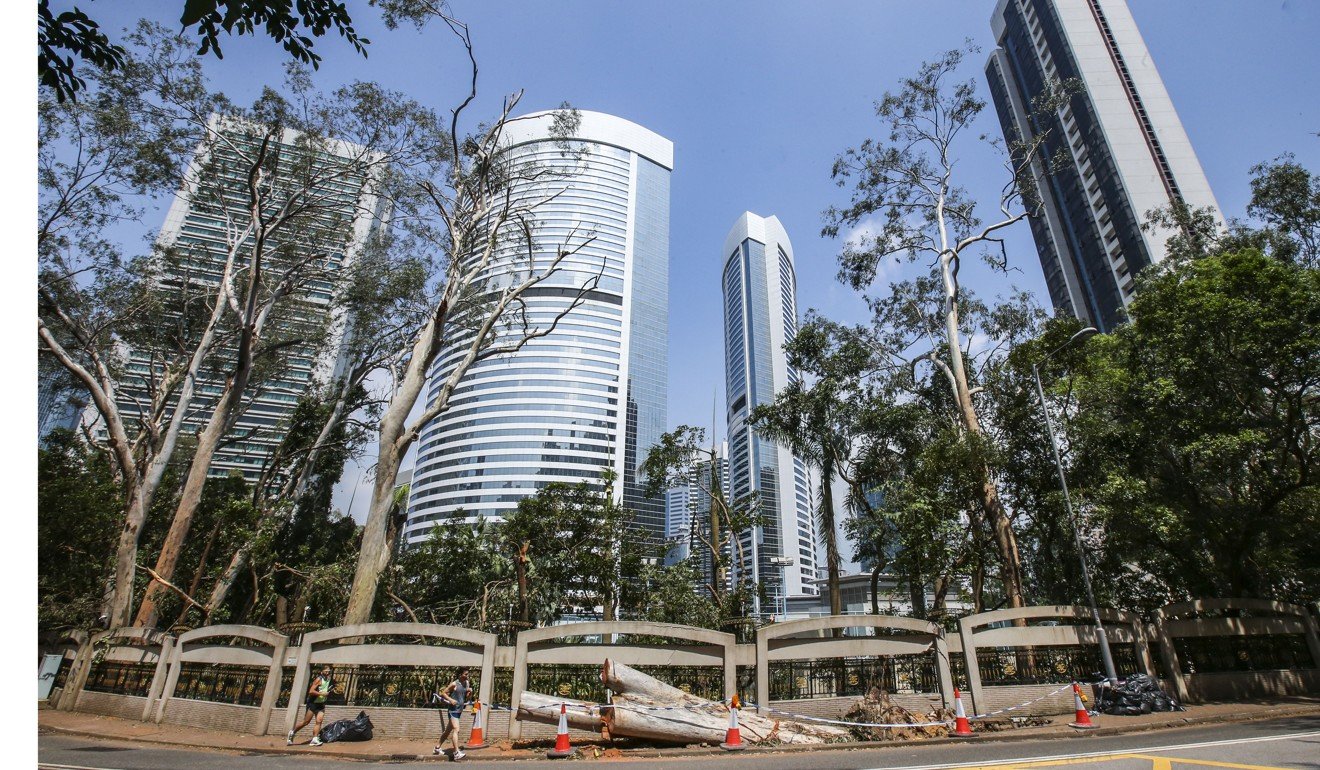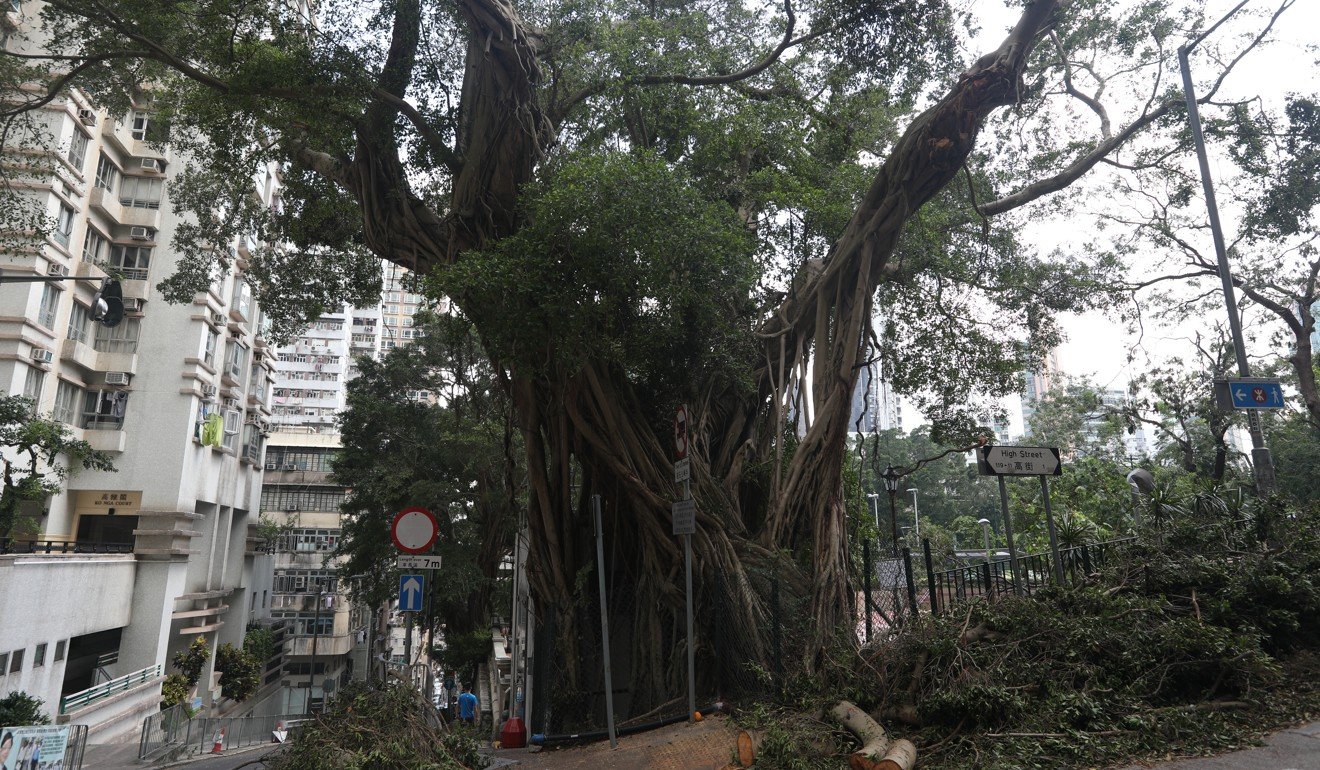
Experts question if 11 specimens on Hong Kong’s ‘Old and Valuable Trees’ list could have survived Typhoon Mangkhut with proper care
They were among more than 17,000 toppled by monster storm, as authorities come under fire over relevance of government register and quality of tree management
Hong Kong lost at least 11 heritage trees after Typhoon Mangkhut ripped through the city, but tree experts have said the monster storm was only partly to blame.
About half of the affected trees were found to be sick and poorly managed before the arrival of the typhoon, which was the city’s most intense on record. Experts questioned if the government had set up adequate protection for the trees.

While more than 17,000 trees were toppled by Mangkhut, the Development Bureau told the Post that 11 of them were on the “Old and Valuable Trees” list, a government register with 474 trees. The list was set up in 2004 with 527 trees but some have died and were removed, while others were added over the years.
Apart from those on the register, two banyan trees at private landmarks – 1881 Heritage in Tsim Sha Tsui and Penfold Park in Sha Tin – were uprooted by the storm. Works are still under way to save the former, while the latter will be removed because of severe damage.
A bureau spokesman said the 11 listed trees would be cleared or removed for public safety.
‘Time running out’ to save historic banyan tree felled by Typhoon Mangkhut
They include the massive century-old Chinese banyan that blocked a lane of Wong Nai Chung Road near the Happy Valley racecourse. The weight of the tree and wind strength was so great that a steel girder in place to prop up the giant specimen had snapped.
The tree, which was 21 metres tall with a crown 23.5 metres wide and a trunk 1.6 metres thick at the base, was estimated to be about 100 years old. Its sheer size meant workers were still struggling to remove it days after the storm.
‘I have feelings for the trees’: Typhoon Mangkhut aftermath sparks bizarre harvest
In the 1990s, the tree and another Chinese banyan were transplanted – at an estimated cost of at least HK$1 million – from Sports Road to make way for the expansion of the Happy Valley racecourse.
According to the official register, the banyan had been considered in “good” health by the Leisure and Cultural Services Department, but placed under observation as another banyan next to it was infected with brown root rot, also known as “tree cancer”, and removed in 2012.
Over in Kowloon Park, one of only two incense tree species on the list also fell victim to the storm.
While the government only said the 11-metre-tall specimen had “obvious wounds” previously, Ken So Kwok-yin, chief executive of Conservancy Association, an NGO, said its decayed roots could have been noticed earlier because of the arched soil around the trunk base.
Hong Kong’s old trees are cut down with good reason, but the people need to know it
“This is a sign that could have been verified with further inspection by drilling into the ground to check the roots,” So said. “But I have not seen any sign of such checks.”
He added that supporting structures could have been set up to help the trees weather the storm.
Jim Chi-yung, another tree expert, also criticised the government, saying it had failed to identify problems with another toppled tree on the list – a lemon-scented gum in Hong Kong Park. The specimen was the biggest of its kind in the city’s urban area.

Jim said the tree fell in the storm because its roots were already seriously rotten and it had a gaping hole at its base. “It would have fallen sooner or later ... It’s a living landmark on Kennedy Road.”
He slammed the government for simply putting the heritage trees on a protected list without taking further steps to rehabilitate them.
“Foreign governments will, for example, nurture the trees with better soil. In Hong Kong, authorities do not enlarge the tree pits even though they are too small for the valuable trees to grow.”
Tree management in Hong Kong under fire after falling branch kills woman
So, who has been checking on trees across Hong Kong after the typhoon, said at least 60 to 70 per cent of those on the “Old and Valuable Trees” list suffered damage such as broken branches and in a most severe case observed in Tai Po, one had lost 40 per cent of its crown.
While admitting the typhoon was especially strong this time, he said the trees could have fared better in the storm had they been properly maintained and cared for daily.
For example, he said, inappropriate pruning, especially for Chinese banyans with dense crowns, made them prone to collapse even when healthy, as there would be uneven wind pressure exerted during a storm.
So also said the government list did not reflect the history of the trees. “Each tree is unique … reflecting the history of the community.” He cited a tree that had wrapped itself around a stone house in Kam Tin in the New Territories, pointing out that the tree had become part of the history of a local clan.
Each tree is unique … reflecting the history of the community
“Now is a good time for us to start discussing drafting a tree law after such a big loss of trees, ” So said. “The super typhoon was a warning to us. We cannot replicate these trees.”
Patrick Lau Hing-tat, a landscape architect and member of the government's Urban Forestry Advisory Panel, said the city’s massive loss of trees highlighted the complications of tree management in Hong Kong.
Weak and sometimes stunted root distributions of trees in the city's dense urban areas meant many were susceptible to root disease or damage. Lau said he suspected the fallen banyan on Wong Nai Chung Road had probably been infected by the same disease.
“Trees that grow next to roads, pavements or areas that are frequently dug up for construction or roadworks are the most vulnerable,” he said. “Roots can become damaged and this increases the chances of brown root rot infection. Once a typhoon hits, they topple over.”

